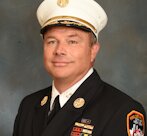Buried in our uniforms: a call to protect firefighters
Beyond law enforcement and the military, few professions are so deeply ingrained in one’s soul and evoke such a profound connection that members would choose to be buried in their uniforms. Fire service members’ love for their profession is part of their DNA, and integral to their very being.
I write this with a sense of frustration. Far too often, we get news of another firefighter’s death from cancer. These dedicated servants, in all likelihood, were or will be buried in their uniforms.
We must do better, and prevent the lives of our brothers and sisters from being cut short.
At what point do we say, ‘Enough’?
When do we take a stand to ensure the future health of firefighters? Cancer has been an increasingly common diagnosis among them for a while now, and it’s time for leadership to take the steps that are needed to address this issue head on.
We are all aware that firefighters are exposed to myriad harmful substances during their service. These dangers range from toxic fumes to hazardous chemicals, and they accumulate in our bodies, taking a toll on our health. Despite advancements in safety gear and procedures, the risks remain significant, and acknowledging them isn’t enough. We must take definitive action to mitigate them.
Leadership in fire departments and governmental bodies must prioritize the health and safety of their firefighters. This includes implementing common-sense procedures that account for firefighters’ long-term health and well-being, and that ensure policy accountability.
Screenings, training, culture
Regular and thorough health screenings should be mandatory to catch potential issues early. Early detection is crucial for effective treatment. If their health problems are identified earlier, firefighters have a better chance of successful treatment and recovery, ultimately saving lives.
Firefighters need detailed training on the risks associated with exposure to hazardous substances and on best practices to minimize those risks. That includes using firefighting gear correctly and understanding decontamination procedures. Proper training empowers firefighters to better protect themselves, reducing the likelihood of exposure and subsequent health issues.
Fostering a culture that prioritizes long-term health within the fire service is essential. Firefighters often prioritize the immediate mission over their health, but shifting this mindset to one that also values ongoing health is critical. Promoting a culture of health awareness encourages firefighters to take proactive steps to protect their health, both on and off the job.
More is needed
We also must be part of the solution, and provide the information that’s needed to develop better strategies and tactics for combating cancer in the fire service. That’s why today, I ask you, whether you are a career or volunteer firefighter, active or retired, to join the National Firefighter Registry for Cancer.
Firefighters understand the value of size-up on the fireground. The information that we gain is critical to informing our strategies and tactics, leading to successful outcomes and lives saved. This is the same way that the NFR aims to “size up” and assess cancer risks.
This information will be used to help us understand occupational cancer better, and to make informed tactical and strategic decisions that will benefit future generations of firefighters. Simply stated, we assist in size-up by joining the NFR.
Protecting our health
We are buried in our uniforms. This must not just be a symbol of our dedication, but a call to protect ourselves. It’s time to say ‘Enough’ and make the changes that will ensure the future health of our firefighters.
Please join the NFR today. The sacrifices that were made by those who were diagnosed with cancer are a stark reminder of the urgency of this issue. Let’s honor them by taking action. Sign up at cdc.gov/niosh/firefighters/registry.html.
Frank Leeb is the managing director of the First Responder Center for Excellence. He previously served as a deputy assistant chief in the New York City Fire Department, and retired in June after more than 30 years. During his tenure with the FDNY, he held several senior staff positions, including chief of the fire academy, chief of training and chief of safety. He has also been a member of the East Farmingdale Fire Department since 1983. He can be contacted at firstresponderconsultant@gmail.com. This article first appeared in Firehouse magazine (firehouse.com) in August.






